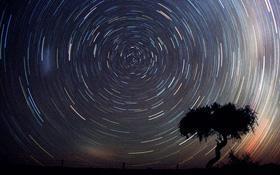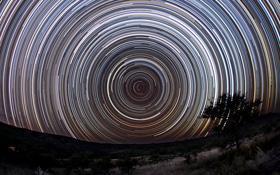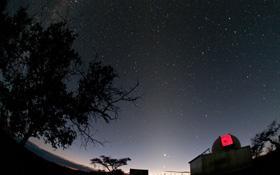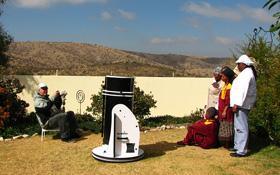Star gazing in Namibia
Stars can be seen throughout the whole world, so why necessarily in Namibia? The connoisseur will shake his head to this question, whilst the laymen will remain puzzled and will fail to understand why so many amateur astronomers repeatedly return to Namibia to view and explore the night sky.
The reason is quite simple: Due to the low population density, the very low air pollution and the virtually non-existing light pollution Namibia offers ideal conditions to explore the southern night sky. One of the best venues for star gazing is the Gamsberg, Namibia’s largest table mountain, with a 2.5 km long and 800 m wide plateau. Until today the Gamsberg is one of the three top venues for star gazing throughout the southern hemisphere. Geographically the Gamsberg forms the highest elevation of the Great Escarpment in the north – south direction between the highland and the Namib Desert. Located about 135 km away from the capital Windhoek and right next to the Hakos Mountains 220 astronomic useful nights with extremely low air disturbances per year can be profited from.
The Max Planck Institute for Astronomy (MPIA), which was founded in the sixties, also recognised this. The institute intended to install a large telescope in the southern hemisphere and expeditions of the MPIA to Namibia showed that the Gamsberg had the ideal requirements for star gazing. Thus the MPIA purchased the plateau from the owner, a local farmer, for 12.000 DM. For the collection of test measurements a small observation ward with a 50 cm telescope and some shack were strenuously build. The results exceeded all expectations and the MPIA decided to erect a 2.2 m telescope for the exploration of the southern night sky.
Unfortunately this project never materialised. Main reason was the political situation of the country, which at that time was still under the South African apartheids regime. The Federal Republic of Germany expressed its concerns against the erection of a telescope on the Gamsberg. There were concerns related to the decisions of the UN that the erection of a large telescope and its international significance could imply an approval of the South African regime. Only in 1990 todays Namibia became politically independent from South Africa.
Second reason was the lack of infrastructure. There was no access to the plateau and the first facilities had to be strenuously carried up on foot until a small, adventurous winding road had been built. Furthermore there was no access to water or to electricity on the plateau.
All these factors made the successful implementation of the project impossible and thus the European Southern Observatory (ESO) erected the 2.2 m telescope in La Silla in Chile.
The Max-Planck – Society did not give up the Gamsberg venue yet. In 1992 plans for the realisation of a 4 m telescope on the Gamsberg were made. The cooperation and financing of this project was to be led by South Africa with Namibia and Germany. The development of an infrastructure, i.e. the building of a reliable access road to the top of the Gamsberg, as well as water and power supply was included. Unfortunately the South African partners announced in 1996 that the government in Pretoria would not be involved in the project of the International Gamsberg Observatory (IGO).
Instead the plans for the erection of the socalled VeryLarge-Telescopes (VLT) with 4 pieces of 8.2 metre mirrors on the Paranal Mountain in the Chilean Atacama Desert were realised. Thus the attempt of the MPIA to build a large observatory on the Gamsberg failed for the second time. As Chile had sufficient high-capacity telescopes by now the need to build a further observatory on the Gamsberg or for that matter the southern hemisphere lapsed.
International amateur observatory on the Gamsberg
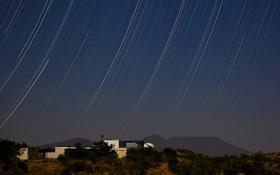 The International Amateur Observatory at Hakos Guestfarm with the Gamsberg in the back
The International Amateur Observatory at Hakos Guestfarm with the Gamsberg in the back
© IAS Observatory Hakos
Due to its outstanding site condition the MPIA decided to make the plateau accessible for amateur astronomers and not to give it up completely. Therefore a foundation was founded in the late nineties, the International Amateur Observatory (IAS). It took over the rights of use from the MPIA, renovated the buildings for observation and accommodation and improved the infrastructure by optimising the water and electricity supply. The small access road is still only passable with a trained driver and a 4x4 vehicle.
By huge initiative of some IAS members a new observatory was built on the Gamsberg, which has international significance for hobby astronomers as it is equipped for example with a 70 cm telescope for observations and photography.
Details of the technical equipment can be obtained from http://www.ias-observatory.org.
Guestfarm Hakos
The IAS also runs another observatory: in view of the Gamsberg, about 20 km away Guestfarm Hakos is located, offering accommodation and further observation possibilities. http://www.hakos-astrofarm.com/
Hakos Guestfarm is run by Walter Straube who, born in 1937 in Windhoek, initially farmed on Farm Hohenheim before buying the neighbouring farm Hakos in 1984. Straube single-handedly converted Hakos into a guest farm, which opened its doors in 1998. The guest farm is situated along the C26 between Windhoek and Walvis Bay at the Hakos Mountains, which reach a height of 2000m. Apart from the initial purpose to offer comfortable accommodation guests have access to sophisticated hobby astronomy. Walter Straube worked for some years for the MPIA on the Gamsberg and most likely got infected with the star gazing virus during this time. Hakos hosts 2 observatories, the Vehrenberg Observatory and the new observatory. Guests that bring along own equipment will find mounting. For technical details please refer to the above mentioned website. Also the non-astronomer will find comfortable accommodation facilities and numerous possibilities to get to know and to explore the surrounding mountains and the flora and fauna. Especially for astronomic laymen Hakos is offering the so-called planet route, which intends to introduce visitors to the secrets of the universe. Excursions to the top of the Gamsberg are also offered.
Every traveller, astronomer or not, will be thrilled by Namibia’s night sky. Not only on top of the Gamsberg, but also on several guest farms professional star gazing and photography are possible. Here, even to the untrained eye, the difference between the northern and the southern night sky becomes evident. In the deep, black sky the Milky Way shines so bright that it actually casts shadows. One has the illusion to be standing right in it. Many star signs, nebulas and galaxies can only be seen in the southern night sky.
But all descriptions, comments and pictures can’t replace the one thing: one has to see and experience it “live”!
Gallery
All pictures were taken at the International Amateur Observatory (IAS). © IAS Observatory Hakos







